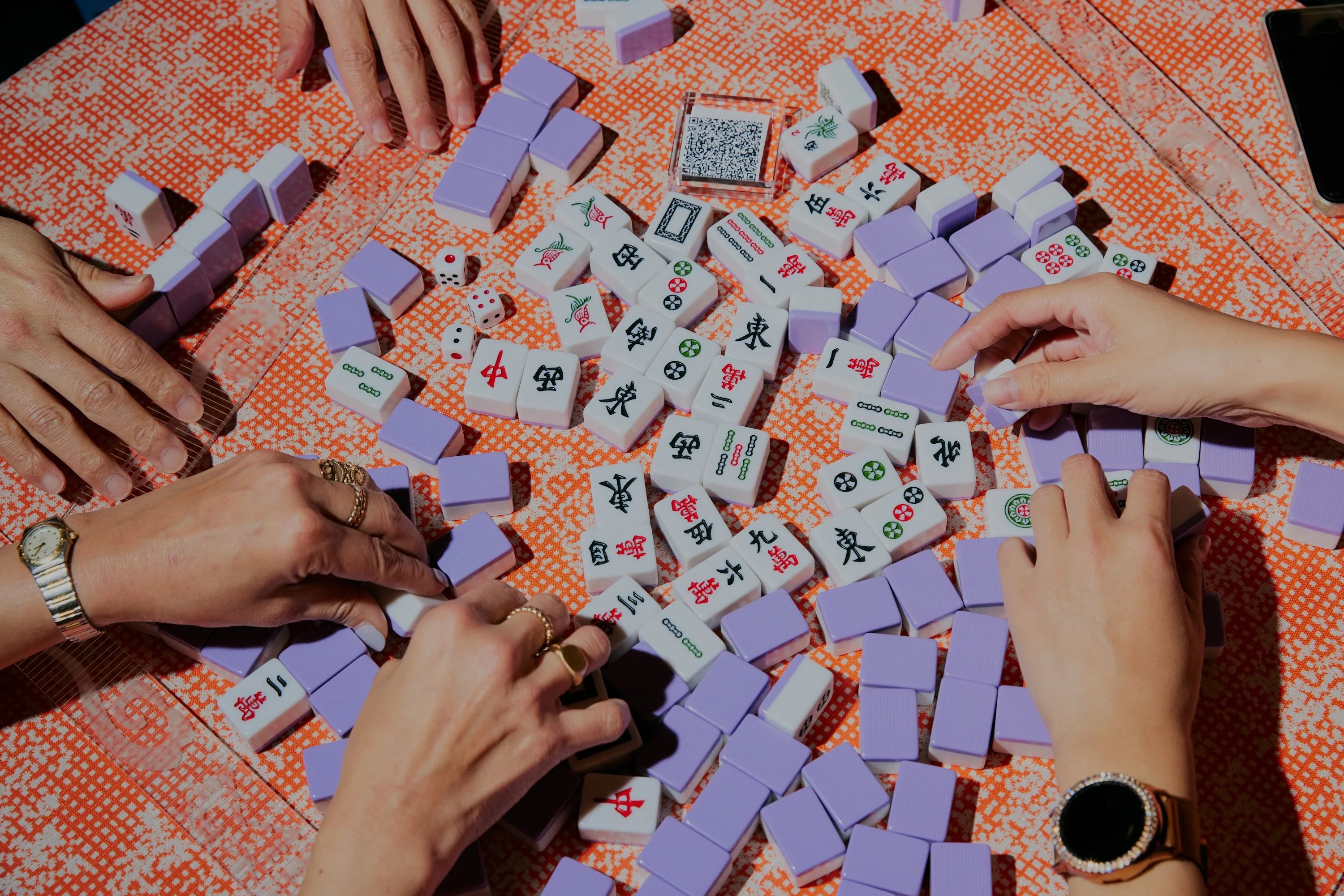In early January, a traditional tile game from China unexpectedly made headlines after three white entrepreneurs from Texas tried to get in on the action. Their company, called The Mahjong Line, offered a cutsey, colorful take on mahjong sets, which replaced any references to Chinese culture with cartoons and catchphrases, for a mere 425USD, and insinuated that they had “upgraded” the game — predictably kicking off a social media storm.
Related:
 This $425 “Gentrified” Mahjong Set is Kicking Off a Social Media StormThe Mahjong Line is a company founded by three white entrepreneurs, aiming to save the game from its unknowing lack of styleArticle Jan 06, 2021
This $425 “Gentrified” Mahjong Set is Kicking Off a Social Media StormThe Mahjong Line is a company founded by three white entrepreneurs, aiming to save the game from its unknowing lack of styleArticle Jan 06, 2021
Netizens called the set “gentrified,” pointing to everything from their implications of “improving” the game to basic design flaws.
What became clear from the controversy is that for entrepreneurs that haven’t done their homework, there’s a lot of nuance to the game of mahjong that can be missed.
So where does mahjong come from, and why has it become a cultural touchstone and essential pasttime — even for people outside of China?
Hazy Origins
Though commonly attributed to the Qing dynasty (1644-1912), it’s still up for debate when — and how — the game to mahjong first came to be.
Some historians believe that Confucius himself invented the game in 500 BCE. Although that hasn’t been verified, the game does owe a lot to the Chinese philosophy of virtues, including sincerity, filial piety, and benevolence. Another group claims that the tiles were invented to combat boredom, when explorer Zheng He led seven ocean expeditions on behalf of the Ming dynasty Emperor in the 1400s. There’s evidence for that theory in some key terminology; for instance, some believe the “tubes” painted on mahjong tiles represent the masts of the boats, while “pong” (“collision,” one of the ways of winning in mahjong) implies two sails colliding.
Most game experts, however, agree that the game evolved near Shanghai in the mid- or late-1800s, and got an upgrade of its own during the 1920s. Later on, the State Sports Commission of China recognized mahjong as an official sport in 1998, and today the World Mahjong Sports Games is also a thing — as well as the possibility of it turning into an Olympic sport soon.
If you didn’t grow up with mahjong in your household, the rules may seem quite complicated depending on what style you learn. Played with a set of 144 titles marked with at least three different suits, the tiles and scoring rules can differ wildly depending on what regional version you play — and there’s one for almost every major area of China’s eastern coast.

Regional varieties of mahjong in China (source: Xianwen Wang et al, 2013)
In some southern areas of China, mahjong is known as the “sparrow game” (máquè, 麻雀), due to the clacking of tiles resembling the chattering of sparrows. And no city is more closely associated with mahjong than Chengdu, nicknamed the “City of Mahjong,” where the locals consider the games an important daily necessity.
From the Streets to the Cinema
In pre-pandemic days, social events and day-to-day street scenes across China would be punctuated with the sounds of clashing mahjong tiles. Four people sit around a table, throw the dice, and draw tile after tile while surrounded by a group of curious spectators — even Bernie Sanders, according to some memes.

The game delivers a great mixture of entertainment and strategy with a dash of Confucian-era ideology and culture.
You can also expect the mahjong sets to be taken out during the Lunar New Year holiday. It’s considered a must-do activity specifically during the Lunar New Year’s Eve celebration; the game symbolizes friendship and family bonds, and embodies the tradition of passing on Chinese culture between generations.
Given the game’s cultural significance, many famous Chinese novels and films have included a mahjong scene. Perhaps the most well-known example in literature is Eileen Chang’s 1979 novel Lust, Caution, which portrays mahjong as the primary entertainment for Shanghai’s rich wives during the Republic of China period. The movie adaptation was directed by Ang Lee in 2007.
More recently, it steered the storytelling in films such as The Joy Luck Club and Crazy Rich Asians.
In the latter, the protagonist Rachel stages a truce over a game of mahjong with her future mother-in-law, Mrs. Young (played by Michelle Yeoh). “My mom taught me how to play,” she offers to Young across the table. “She told me mahjong would teach me important life skills — negotiation, strategy, cooperation.”

Journey to the West
Well before The Mahjong Company’s big gaffe, the game’s inroads overseas have been centuries in the making.
Mahjong first came to the United States via an American named Joseph Park Babcock, a representative of the Standard Oil Company in Shanghai. He imported mahjong sets to the United States, and Abercrombie & Fitch became the first company to stock mahjong sets in stores, selling around 12,000 sets a year. Within the fraught context of immigration and discrimination at the time, mahjong gave Chinese Americans a common cultural bond at a time when other Americans saw them as outsiders.
Meanwhile, mahjong was taking off in the UK, though the British tended to adhere to the original Chinese rules of mahjong and avoided those devised by the Americans (typical).
It wasn’t until 1986, however, that American mahjong rules and tournaments were finally standardized. Amy Tan further cemented the game in popular culture with her novel-turned-movie The Joy Luck Club, which talked about intergenerational conflict within a Chinese immigrant family.
“My father has asked me to be the fourth corner at the Joy Luck Club,” writes Tan in the novel. “I am to replace my mother, whose seat at the mah jong table has been empty since she died two months ago. My father thinks she was killed by her own thoughts.”
In the US, the game has also become a beloved pastime in the Jewish community. Mahjong, or “mahj” as writer Jessica Turnoff Ferrari grew up calling it, has for decades been “a way of life” for a generation of Jewish-Americans — much like it is in China.
That helps explain how it reached Sarah Jessica Parker; in 2018, the Jewish-American actress gushed on Live Kelly and Ryan that she “loves mahjong,” and posted a year later on her Instagram about her new tile set, adding that if “it’s Sunday evening, it’s Mah Jong.”
Mahjong Youth
In China, mahjong is most often thought of as a game for retirees to pass the time and keep their mental faculties sharp. But are young Chinese people getting in on the game?
For some, it’s actually spurned some pretty intense debates (and internalized guilt) about their lifestyles.
In 2019, the question, “Is it a waste of life for young people to play mahjong?” sparked a heated debate on Chinese social media, referring specifically to the game’s addictiveness. In a related post on “China’s Quora,” Zhihu, a user in her 20s wrote that she “felt guilty” for spending four days playing nonstop mahjong while visiting her friends in her hometown. Esteemed sociologist Li Yinhe weighed in in the comments, suggesting that the game is actually a “double-edged sword.”
“On the one hand, it numbs our nerves like opium and makes us reluctant to do anything but to settle for random existence,” she wrote. “On the other hand, it enables us to obtain peace of the soul, to live a leisurely life, and to endure the meaninglessness of life, the painful fact that all mankind and every individual must face.”
But for others, mahjong doesn’t demand that much thought, or guilt — it’s a harmless way to pass the time and make friends. In a three-part story posted to social media site Douban, a user from the city of Changsha recalled bonding with Chinese classmates over mahjong while living in the United States.
“So many Changsha people I know are clamoring for [it], but none of them have mahjong!” laments the writer in his tale, “And online mahjong just isn’t the same!”
On China’s biggest ecommerce platform, Taobao, you can endlessly scroll looking for the perfect all-mechanical mahjong table, or tile sets in electrifying colors that would make those Texan entrepreneurs green with envy.
As a generation of mahjong players reaches its twilight years, it remains to be seen whether the next generation will keep the game alive. One thing is for sure, however — if you crave a hobby with hundreds of years of history that demands strategy, speed, and skill all at once, mahjong will become your new favorite game.
Header image: Taobao
















